June / July 2020
The borders in Europe were closed for several months from mid-March 2020 due to the coronavirus COVID-19 crisis. Italy was the first European country to open its borders unilaterally for foreign guests in early June. Besides a few short trips to Tuscany, Northern Italy, Venice and Sicily, the last time I traveled around the country for a longer period of time was more than 30 years ago, because mass tourism in Italy always put me off.
Now the unique opportunity arose to travel around Italy almost without tourists, because very few people had the time and courage to visit the country immediately after the opening of the border. And indeed it was an extraordinary trip. My colleague and I were almost always the only and first foreign tourists after the months of lockdown. The hotels were mostly empty, so we could book at short notice and at attractive prices.
As Northern Italy was more severely affected by the virus at that time, we traveled directly to Florence.
Table of Contents
Florence
Cathedral of Florence (Italian Cattedrale di Santa Maria del Fiore)
The area around the cathedral ‘Cattedrale di Santa Maria del Fiore’ was almost deserted.


Ponte Vecchio
View from Palazzo degli Uffizi to the Ponte Vecchio

The Uffizi – Galleria Uffizi
The Uffizi Gallery contains the world’s largest collection of Renaissance art, with works by Leonardo da Vinci and Botticelli, among others. After a 15 minute wait we were able to enter the museum. Also here we were the only foreign tourists.
The ‘Birth of Venus’ by Botticelli from 1485

‘Madonna del Magnificat’ by Botticelli from the year 1483
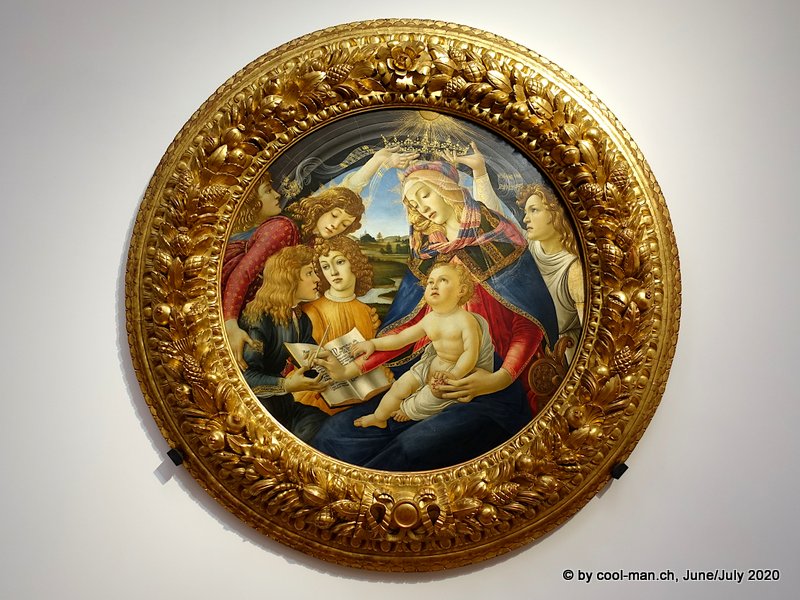
‘Judith and Holofernes’ by Pieter Paul Rubens 1626-1634

The copy of the statue of David by Michelangelo in the Piazza della Signoria. The original has been standing in the Galleria dell’Accademia in Florence since 1873.

The statue of Leonardo da Vinci on the Uffizi Square

Palazzo Vecchio
The Palazzo Vecchio is the town hall of Florence.
The most impressive room is the 52 m long Salone dei Cinquecento.

One of the beautifully detailed ceilings in the palace
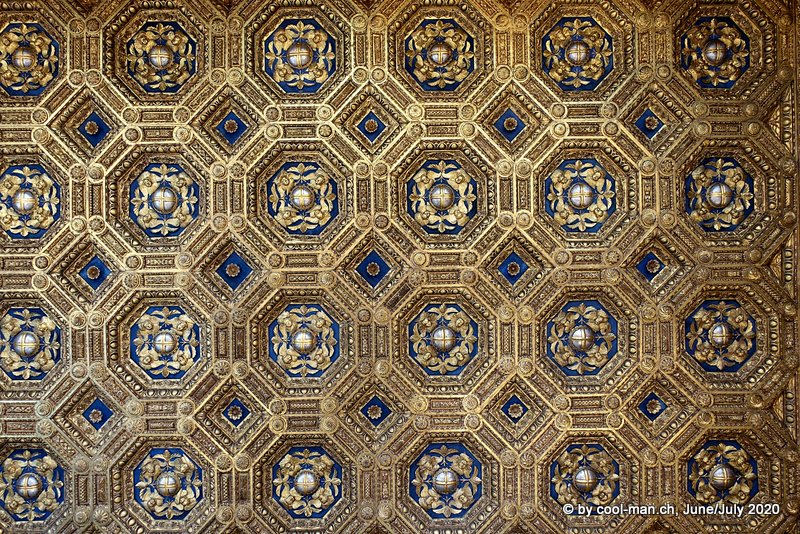
I tried to reserve a table in the restaurant ‘Enoteca Pinchiorri’ at short notice. For decades it has been one of the best restaurants in Italy. I have been there twice, but the last time was about 25 years ago. Unfortunately, no one answered the phone and also at the door I did not get an answer when I went to the restaurant at noon to make a reservation for the evening.
Perugia
On the way south we stopped for a night in Perugia, where we visited the Rocca Paolina fortress from the Renaissance period. It was built for Pope Paul III for his protection.
In the Renaissance fortress Rocca Paolina

Rome
Vatican
Vatican Museum
While during normal times a waiting period of 2 hours is usual until the admission to the Vatican Museum, we could enter immediately during our visit.

The museum (almost) for us alone!




St. Peter’s Basilica
The smallest army in the world: The Pope’s Swiss Guard

The construction of a monumental church was begun in 1502 under Pope Julius II, as he could not imagine being buried in the old and dilapidated Saint Peter’s Church. The church was financed with the Peter’s Penny (a donation from the faithful) and the sale of indulgences, which relieved sinners of the punishments in purgatory for their sins. This practice was a trigger for the Reformation. Later, Spain also contributed a part thanks to the treasures captured from Central and South America.
Inside the St. Peter’s Basilica – impressive



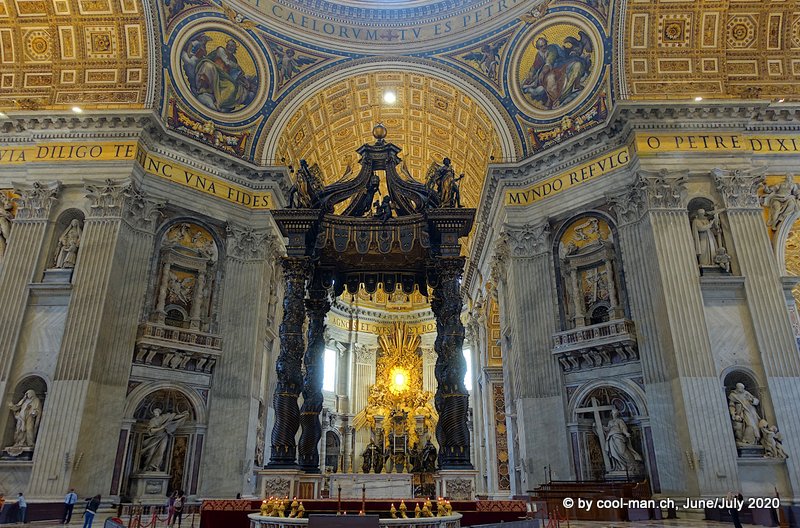
I also visited the Sistine Chapel with its famous paintings. However, I did not find an angle from which I could take a photo worth seeing.
View of the Vatican from the roof of St. Peter’s Basilica

Fountains of the four rivers in the Piazza Navona (ital. Fontana dei Quattro Fiumi)


Forum Romanum and Palatine Hills
Palatine is one of the seven hills of Rome and is the oldest inhabited part of the city.

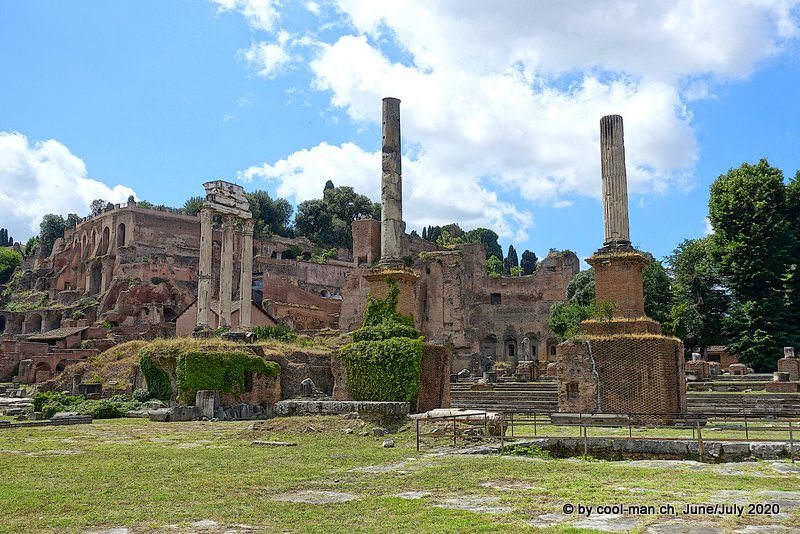
No tourists here either


Colosseum
Built between 72 and 80 AD, the Colosseum is the largest amphitheater ever built.


Basilica di Santa Maria Maggiore
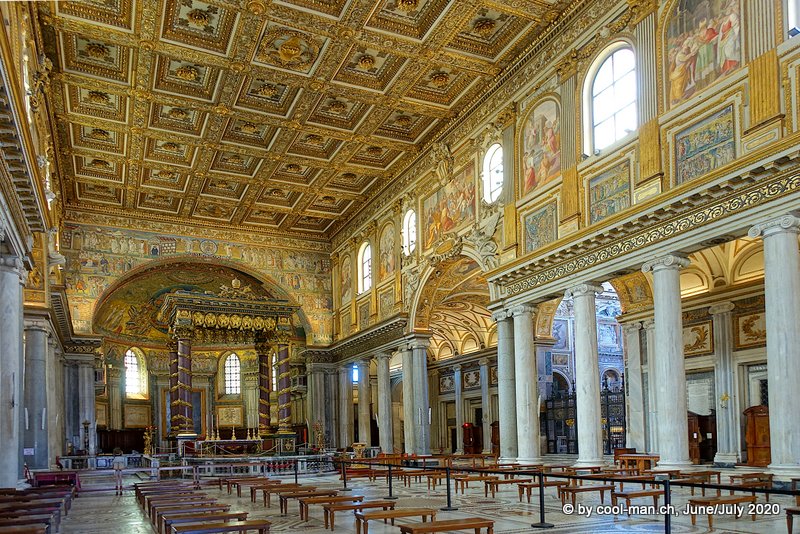

Trevi Fountain
The fountain marked the end of a Roman aqueduct that brought water to the city. It is the largest baroque fountain in the city and one of the most famous in the world. The name derives from the three streets (ital. tre vie) that begin from the fountain.
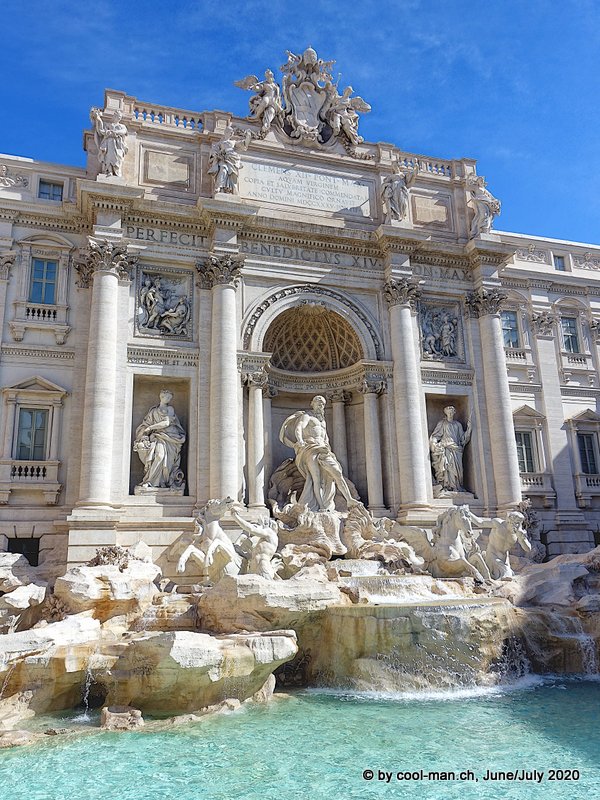

Galleria Borghese
The house of Cardinal Borghese, a nephew of Pope Paul V, is very impressive, as the pictures show. Where did the churchman get the financial means to build this house and build up a wonderful art collection? The house served him as a country house, which at that time was located on the outskirts of the city.



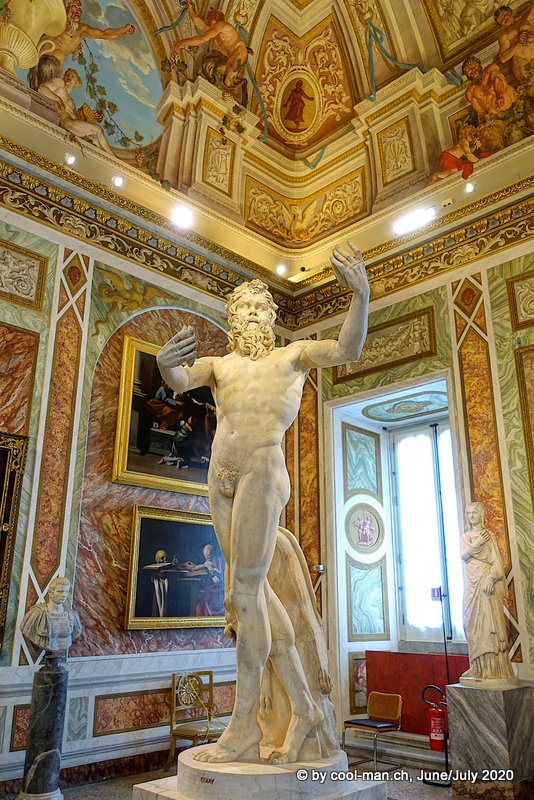
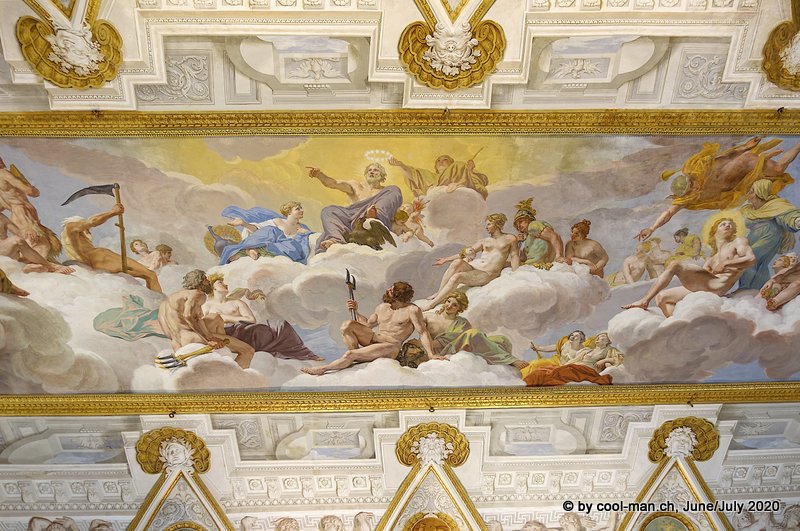
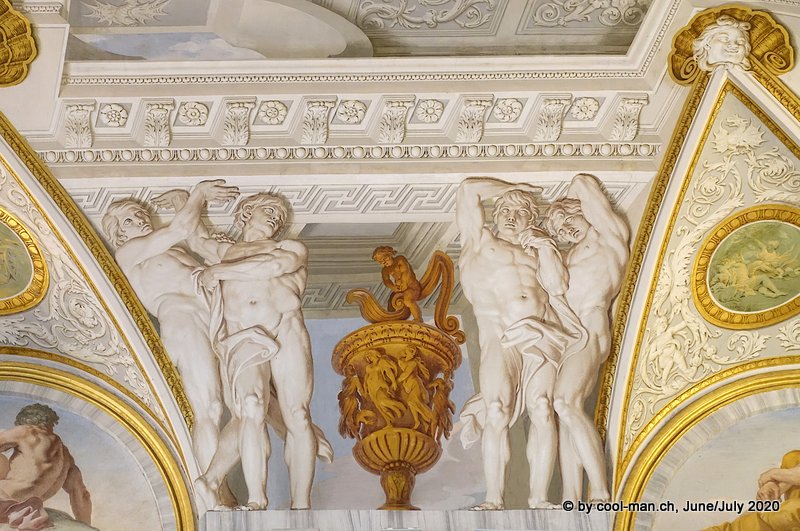
Gourmet Restaurants
It is usually impossible to get a table at short notice in the capital’s top restaurants. Thanks to the Covid-19 crisis I was able to make reservations at these extraordinary restaurants only a few days in advance.
La Pergola
Unfortunately I couldn’t visit the best restaurant in Rome with three Michelin stars, because it hadn’t opened its doors since the lockdown yet.
Il Pagliaccio
This inconspicuous restaurant Il Pagliaccio on Via Dei Banchi Vecchi, with its two Michelin stars, is the second best in the city and indeed the food was a special experience.
Il Convivio Troiani
A visit to the one-star Michelin restaurant Il Convivio Troiani was equally worthwhile, as it further developed traditional dishes from the province of Lazio and all of Italy to a very high level.
Ostia Antica
With the suburban train I reached Ostia Antica, 23 km from Rome. The place was the port city of ancient Rome.


The columns were made of bricks and covered with a marble-like coating.
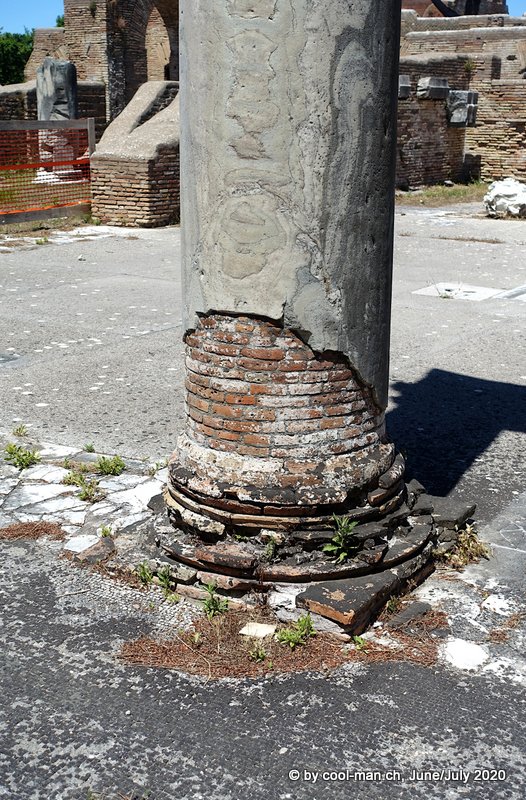
Amphorae containing liquids.

Architecture

Mosaics


A 2000 year old floor with a sophisticated design

Naples
Museo Archeologico Nazionale
This museum in Palazzo Vitelleschi dating back to the 15th century contains extensive collections of Greek and Roman art treasures.
The oldest representation of the Greek titan Atlas.



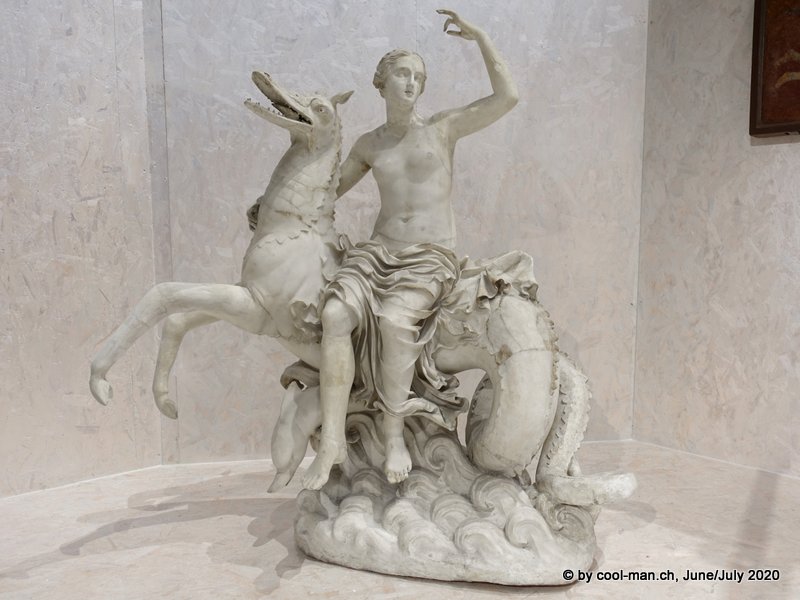



A contemporary artist staged ancient statues in the present.


Charterhouse and Museum di San Martino and the Sant’Elmo Castle
On a hill above the city are the Charterhouse di San Martino and next to it the Castle of Sant’Elmo, both with a great views.
View from the Charterhouse di San Martino

and from the Castle of Sant’Elmo. In the background the volcano Vesuvius.

Galleria Umberto I
A shopping gallery built between 1887 and 1891 in the center of Naples.

Castel dell’Ovo
The Castel dell’Ovo is the oldest still existing fortress in Naples. This peninsula was already inhabited in Greek times and in 476 A.D. the last Roman emperor Romulus Augustulus was exiled here.
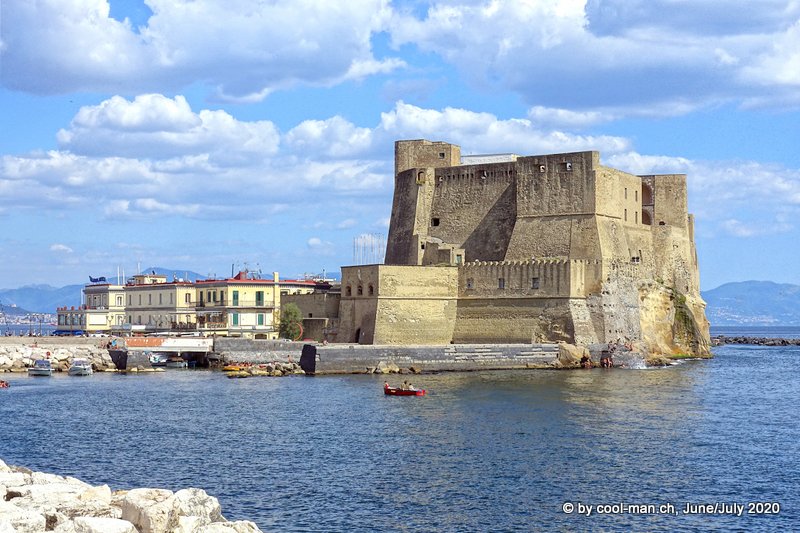
Pizzerias
Naples is famous for the best pizzas in the world. A colleague sent me a link to a website with the best pizzerias in Naples.
Da Michele
The ‘Da Michele’ was number one on this website. Before the coronavirus COVID-19 crisis, people queued up in front of the restaurant for over an hour. This pizzeria is also mentioned in the ‘Michelin’ restaurant guide. We had lunch and due to the lack of tourists we were already sitting at the table after a few minutes.
The pizzeria ‘Da Michele’ with all the awards at the entrance

For me this was by no means the best in the world. The underside and part of the edge were burnt, which caused the pizza to have a bitter aftertaste.

Brandi
The next day we visited the Pizzeria Brandi, the number 3 on the list of the best pizzerias. We chose this pizzeria because the then owner Raffaele Esposito had invented the Pizza Margherita in this pizzeria. In 1889 King Umberto I and his wife Margherita of Savoy were visiting Naples, where they lived in the nearby Summer Palace. Raffaele Esposito was commissioned to create three different pizzas for the royal couple. The Queen liked the pizza with the three national colors of Italy (basil for green, mozzarella for white and tomatoes for red) best, so from then on this pizza was named after her.


This Pizza Margherita was simply perfect and with € 6.50 even cheap!

Herculaneum
The Roman city of Herculaneum, which is only 13 km away from Naples, was destroyed by the eruption of the volcano Vesuvius in 79 AD, as was Pompeii. A thick layer of ash covered the city, which also perfectly preserved organic materials. Herculaneum was a popular seaside resort for the Roman elite, which was reflected in the luxurious decoration of the houses.
Most of the inhabitants of Herculaneum were evacuated in time. These people were still waiting for rescue and sought shelter in the boathouses that were then located on the coast. They were immediately killed by the 500 °C heat wave.

A bar
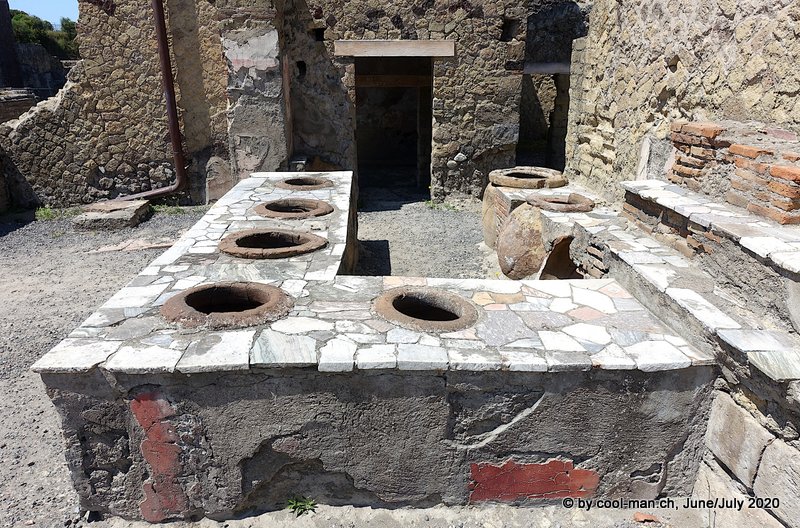
Luxurious interior of the houses




I was very impressed by the variety of floors in Herculaneum and Pompeii, which I have captured on a separate website.
In times of the coronavirus COVID-19 the middle seat remains free.

Pompeii
Afterwards, I took the suburban train to visit Pompeii, another 16 km away. On a usual summer day about 10’000 people visit this famous tourist attraction. On this afternoon I estimated the number of visitors at 50.
A street in Pompeii without tourists. In the background the volcano Vesuvius.

The main square of the city

The Amphitheater

A villa








I was very impressed by the variety of floors in Herculaneum and Pompeii, which I captured on a separate website.
Amalfi Coast
We continued by train and bus to Positano, the largest town on the Amalfi Coast.
The steep coast, the small villages and the views over the blue sea are impressive. The area has therefore been declared a UNESCO World Heritage Site.
A part of the village of Positano

The village of Amalfi …

… and its beach

View from the Path of the Gods (ital. Il Sentiero degli Dei)


The lemons of the Amalfi area are especially praised and are the base of the wonderful Limoncello liqueur.

Parking with a view

Villa Rufolo and the village of Ravello
The historical Villa Rufolo has stood high above the Tyrrhenian Sea since the 13th century. Richard Wagner created the second act of the opera Parsifal here. Nowadays, visitors are delighted by the magnificent view and the garden.

Not far from Villa Rufolo I enjoyed this octopus. Delicious!

On the way out of the restaurant we passed this pizza baker. The dough should be sufficient for 120 pizzas.

Capri
From Positano we traveled on to Capri with a scheduled boat. The spectacular island has been a tourist destination since Roman times.
We were told that on usual summer days up to 20’000 people, mostly from cruise ships, crowd through the narrow streets of the town. On our trip we reserved the Airbnb apartment a few days before our arrival and hardly ever met foreign tourists.
The picturesque port of Capri
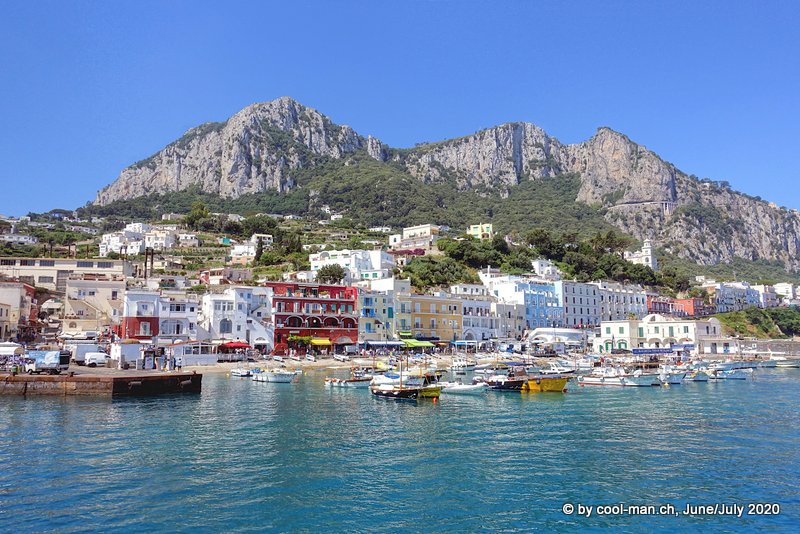
The town square

The seafood risotto at the Pullali Restaurant

We sat on the balcony of the restaurant and enjoyed the sunset while eating. What more could one want?

Villa Lysis
The villa was the exile of the French Baron Jacques d’Adelswärd-Fersen, who had to leave Paris because of sex scandals with minors in 1905. At that time Capri was already known as a refuge for homosexual and bisexual visitors.
The garden of the Villa Lysis

Gardens of Augustus
A statue in the gardens of Augustus (ital. Giardini di Augusto). Originally the garden was part of the estate of the German industrialist Friedrich Alfred Krupp.

Via Krupp
The path from the gardens of Augustus to Marina Piccola was also initiated by Krupp. The path had a turnoff to the Grotta di Fra Felice. Krupp was accused of having held sex orgies with local youths in this grotto. That is why he had to leave the island in 1902.
The Via Krupp was closed several years ago because of rockfall.

The view point Belvedere Tragara
Views


Villa San Michele
The Villa San Michele near the village of Anacapri was built at the end of the 19th century by the Swedish doctor and writer Axel Munthe and is now a museum.

The statue of the former owner Axel Munthe
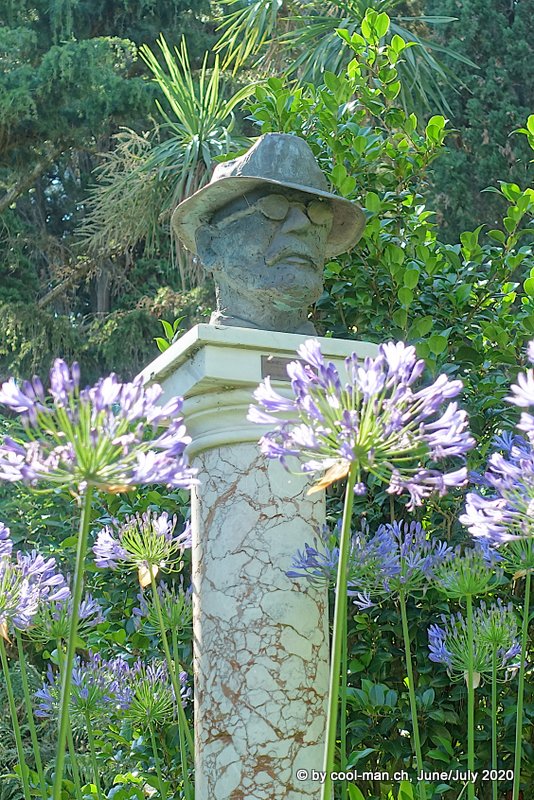
During the 1920s, the extravagant Countess Casati Stampa rented the property, who attracted attention even in the European high society because she sometimes went for a walk with two cheetahs on a leash or wore live snakes as jewelry. She had her motto “oser, vouloir, savoir, se taire” (dare, want, know, keep silent) painted on a wall. Axel Munthe liked the lettering and so it can still be seen today.
The magnificent view of the Tyrrhenian Sea


Monte Solaro
Afterwards I climbed the highest point of Capri at 589 meters.
View from Monte Solaro over the steep coast to the sea

Here I met my colleague again and we went on by bus to the Blue Grotto (ital. Grotta Azzurra).
Grotta Azzurra
In front of the grotto the rowers wait in their boats to bring the tourists into the grotto.

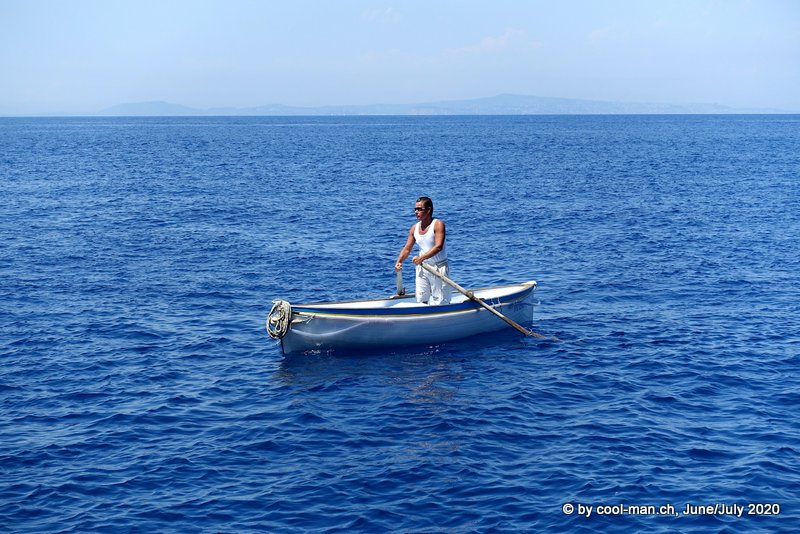
The red components of sunlight shining through an underwater cave are filtered out so that only blue light enters the cave.

We then walked, interrupted by a swim in a lonely bay, along the Fortini coastal path to the Punta Carena lighthouse (ital. Faro Punta Carena).
Punta Carena Lighthouse

On a boat tour around the island I saw more sights.
Green grotto (ital. Grotta Verde)

White Grotto (ital. Grotta Bianca)

Another villa on one of the cliffs of Capri

Restaurant ‘A Curtiglia’ near Anacapri
I spent one of the most beautiful evenings in Capri at the restaurant ‘A Curtiglia’ near Anacapri.
On the way from the bus station to the restaurant

Sunset seen from my table on the terrace. On the horizon I already saw my next destination, the island of Ischia.

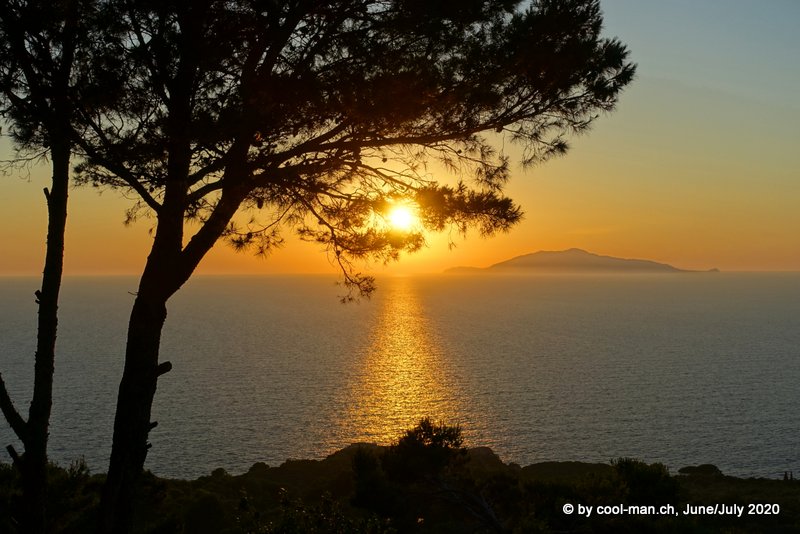
The main course: Fresh prawns with squid ink pasta – a dream

… and the afterglow

My colleague returned to Rome and I took the regular ship from Capri to Ischia.
Ischia
The Aragonese castle of Ischia
As early as 474 B.C. the first fortress was built on a 113 meter high rocky offshore island. After an eventful history, the Aragonese built the present castle in 1441.


While I was eating this wonderful spaghetti vongole dish …

… I saw the moon rising over the castle. Without further ado I left the restaurant for a few minutes to take the picture below.
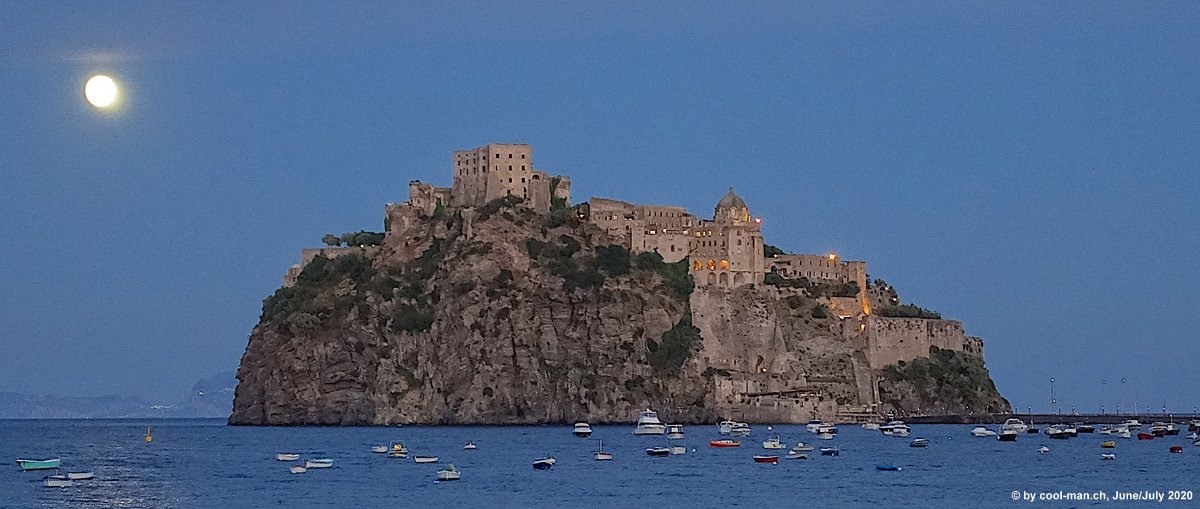
View from the castle to Punta Molina

Between 1575 and 1810, the Aragonese Castle housed a community of nuns belonging to the Order of Saint Clare. They buried their dead nuns in these chairs, where they slowly decayed. The living nuns visited their dead sisters regularly and prayed.

An empty beach

The port of Ischia

A display window with decorative lemons in a shopping street shows how important this fruit is also on Ischia.

Sant’Angelo
In the southernmost part of the island lies the small fishing village of Sant’Angelo, probably the most beautiful on Ischia. In front of the village there is a rock which is connected to the village by a sandy strip.
View from the village to the rock at different times of the day

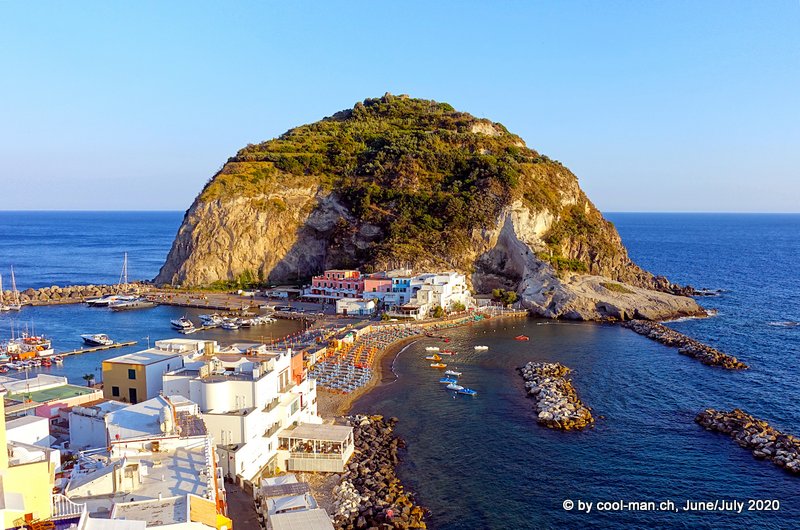

The ‘Villa Sirena Restaurant’ quickly became my favorite restaurant thanks to its excellent food, the various craft beers and the great view.

The ‘fumalore’ bear witness to the volcanic activity in the area.

Near Sant’Angelo, in the bay of Sorgeto, there are hot springs that feed different hot pools. Afterwards the water flows into the sea.
Procida
Procida is a small island between Ischia and the Italian mainland. Because of its authenticity, it has been the setting for over 30 films, including Cleopatra, Il Postino and The talented Mr. Ripley.
The fishing village of the same name is particularly picturesque.

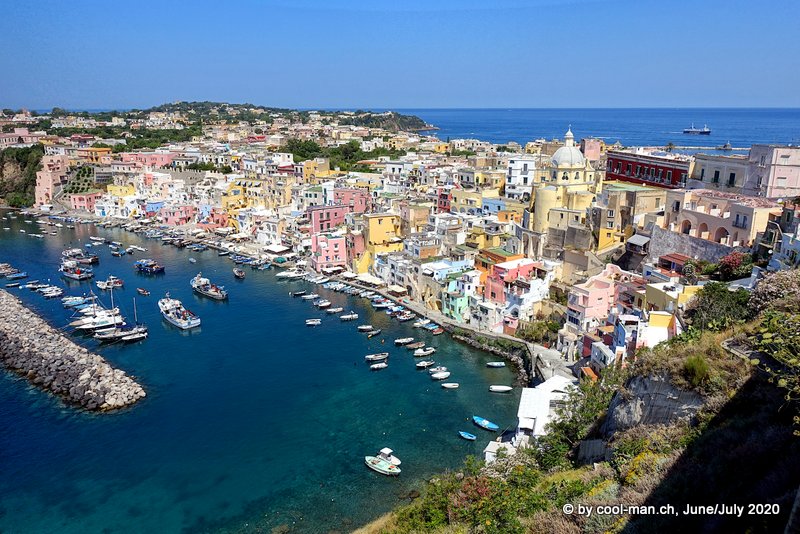


Fishermen bring freshly caught mussels to the harbor.
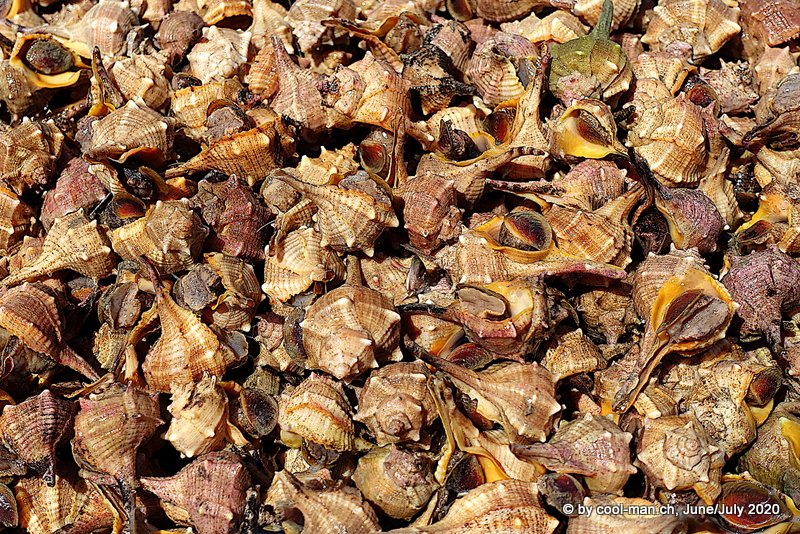



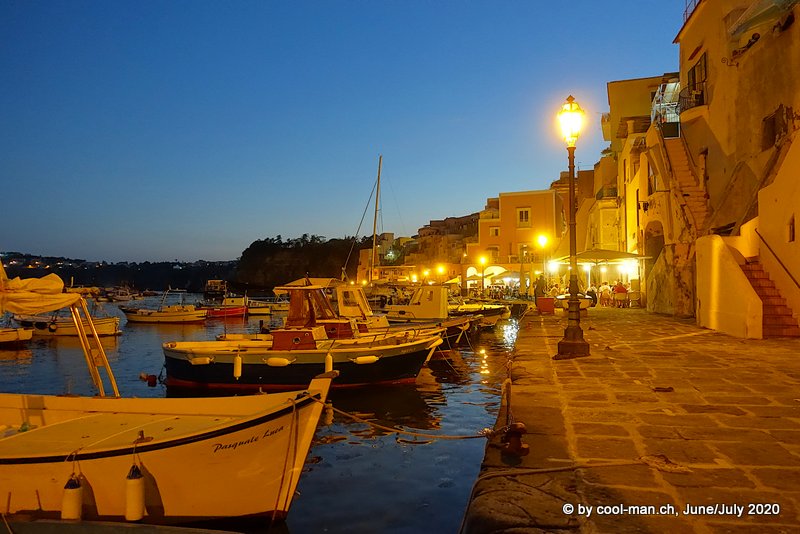

Since the school vacations were to start soon and I expected more tourists, I ended this impressive three and a half week trip and flew back to Switzerland.
This text is an automatic English translation from the German original by deepl.com